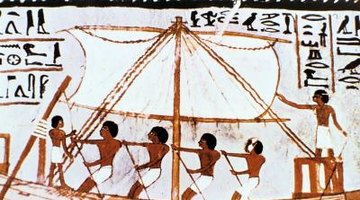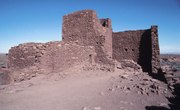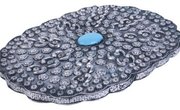Watercraft were important for the ancient Egyptians due to their proximity to and relationship with the Nile River's life-giving waters. Boats embodied symbols of status and power for the ruling classes, facilitated the trade of common and luxury goods within Egypt, and expanded the empire's reach among other ancient cultures of the Mediterranean and Red Sea.
Papyrus to Cedar
Rafts consisting of papyrus reeds lashed together are among the earliest forms of Egyptian watercraft and are portrayed on artwork from as early as 4000 B.C. Egyptians developed carpentry techniques with stone tools around 3500 B.C. and began building wooden boats from native tree species such as sycamore, acacia and tamarisk. The inclusion of copper tools and imported cedar from the Mediterranean over the next 1000 years helped advance Egyptian boat design even further, with increasingly larger, sail-bearing and more sophisticated vessels.
Goods By River and Sea
Ancient Egyptian boats transported luxury items and raw goods from ports in the Red Sea, Mediterranean and along the Nile River. Turquoise and copper were among these items, according to an inscription from the Mit Rahina archaeological site that detailed a voyage to Sinai in 2007 B.C. For use in the construction of their ocean faring ships, the Egyptians imported cedar from the people inhabiting the coastal areas of modern Lebanon or Syria. Other imports included spices, frankincense, iron and tin, while they exported papyrus, pottery and perfumes. Barges (flat-bottomed boats) were used specifically for transporting limestone, granite and other rocks used for monument construction from quarries along the Nile near the sites of Aswan and Tura. Boats also brought tribute, including gold, ebony and ivory, from distant lands.
Empire on the Water
Egyptian boats played a critical role in transporting personnel, including troops, diplomats and constabulary (policing forces). The Egyptian navy engaged in war and supported ground forces during times of empire expansion, such as against the Mitanni and Hittites of northern Syria during the later parts of the New Kingdom era in roughly 1450 B.C. A combination of steering rudder, oars for rowing and square ship sails made Egyptian warships highly maneuverable. Hull designs included raised gunwales to defend against enemy archers, high platforms to fire arrows and front rams to sink enemy ships.
Symbolic Importance
Boats were embedded within Egyptian culture from the mundane to the divine. The Egyptian sun god Ra often stands astride a solar boat in artwork, making his journey from sunrise to sunset. Miniature boat models were placed in tombs and around coffins starting near 2025-1700 B.C., often depicting carved, wooden workers and oarsmen. Some pharaohs expressed the state's inherent power and their own divine nature by ordering expensive funereal boats buried within their tombs, such as the 14 wooden ships discovered at the Abydos funeral complex, originating from the First Dynasty (3100-2900 B.C.) Such boats carried out one final task -- taking deceased royalty into the afterlife.
Related Articles
References
Resources
Writer Bio
DaVaun Sanders' passion for writing hails back to the summer of 2002. He writes regularly for PhxSoul.com, is a New America Media Ethnic Elders Fellow and is currently editing his first novel. Sanders holds a bachelor's degree in architecture from Washington University.











